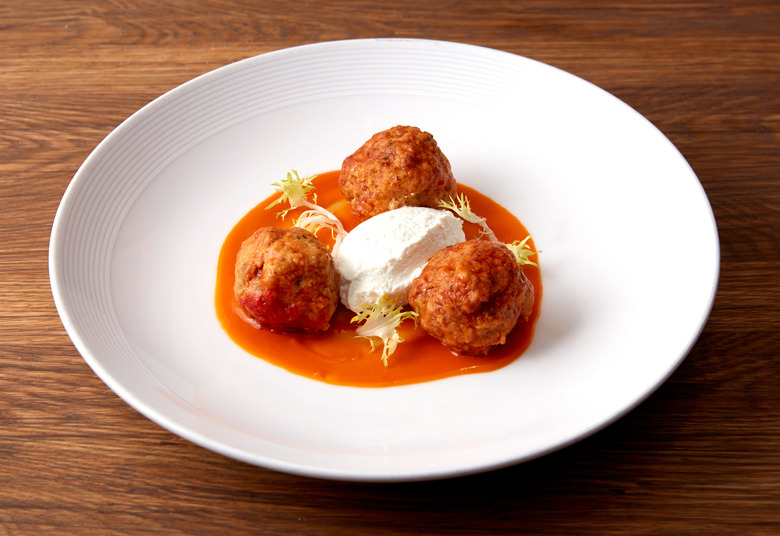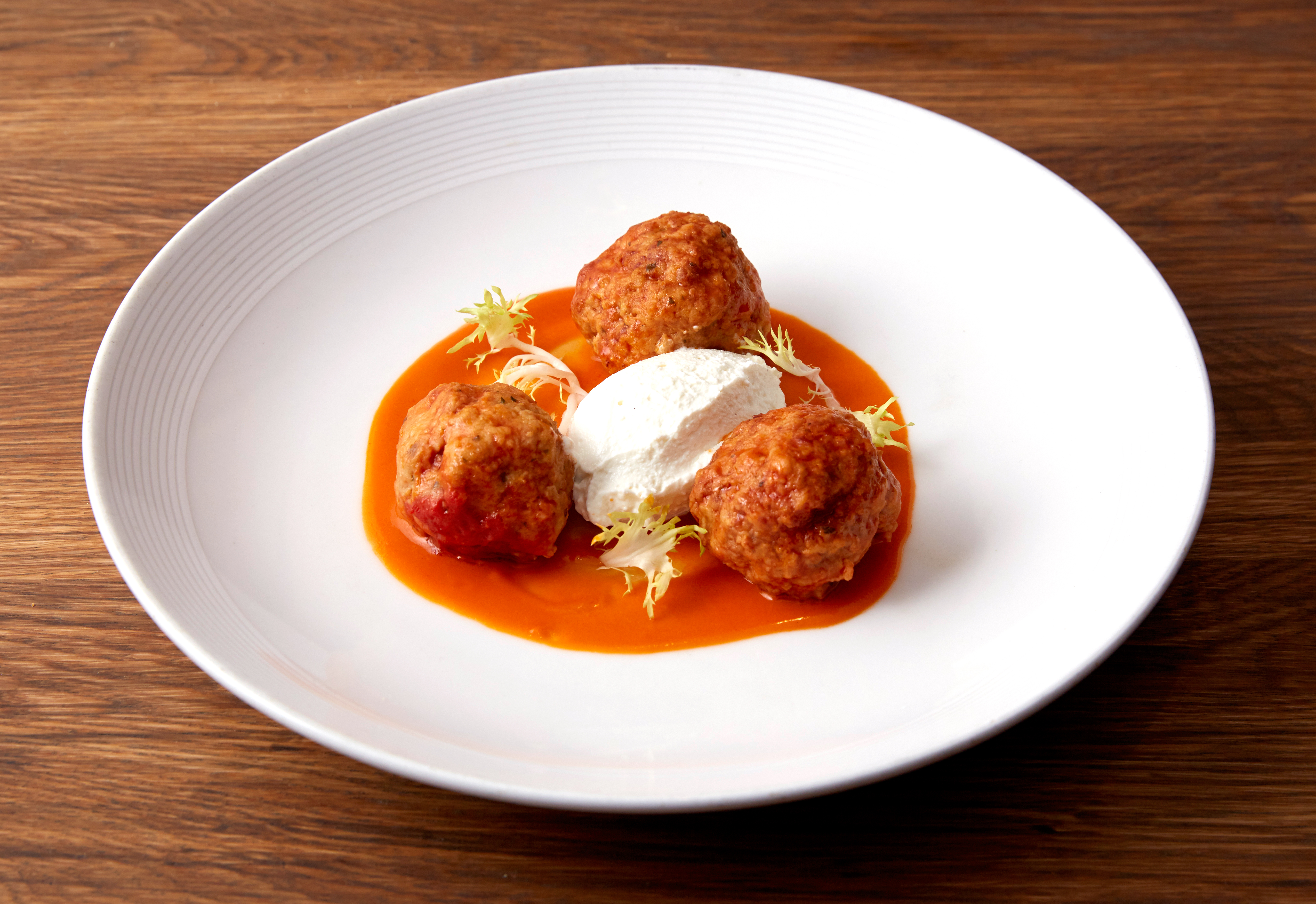Blue Salt, 25 Spoons, Oval Pies, And Other Secrets Of The Decades-Long Run Of New York City's Altesi Restaurants
Alavian, owner of Altesi Madison and Altesi Downtown, says he isn't a chef — yet he is full of culinary know-how that seems to be part of an experiential education that all Italian children receive. One of those culinary tidbits is behind the secret to the restaurants' meatballs. The recipe calls for a very specific kind of blue salt — which must be allowed to breathe for four days before it is used.
Intrigued? So were we, especially when he offered this nugget of advice: Give your kitchen staff a certain number of spoons at the beginning of service — about 25 — and make sure they've used up almost all of them before their shifts end. Why? To make sure everything tastes right — after all, he says, the biggest mistake you can make in this business is complacency. Although Alavian earned a degree in pharmacology at the University of Perugia, he decided to pursue a career in the restaurant business, an interest he developed while he was working as a waiter during his early years in the U.S.
Alavian shared what truly makes a successful "modern Italian" experience in 2017 and the mistakes other Italian restaurants in New York City make, how he negotiates tradition and taste with the mounting pressure of an Instagram-worthy presentation, and the multi-purpose functionality of the wooden-board pizza trend that's emerging from brick ovens everywhere.
The Daily Meal: What are three key things to know about Italian hospitality?
Paolo Alavian: It is crucial to always remember the names and greet regulars by their first names; this makes them understand you care. Second is making them feel like family when they come. I love to talk to customers not just about food and their meals but about life, politics, the inner workings of the restaurant. People love being friends with the owner of their local restaurant, and it makes them feel good about going there. Lastly, remember what people drink, but ask them anyway and present their drink of choice as though it was the first time they ordered it.
What do you think defines "modern Italian" in 2017, and what are some of the traditional staples people don't want to see leave the menu?
Food of any cuisine has become more fashion-oriented with the rise of Instagram. I have seen a lot of establishments rise to immense success, and I've even gone to try some of the items found online to see what the fuss is about. More often than not, it's a disappointment. Altesi tries to present dishes in such a way that is "Instagram worthy" but still tastes great. Also, modern Italy is in flux at the moment, as is much of the world. Italy has a reputation of resisting change, especially when it comes to food. Everyone wants the same five things on the menu or else it is not "Italian" to them. However, those five things are sometimes the hardest to pull off well.
Pasta al sugo is not just pasta and tomato sauce. I have rarely had truly al dente pasta in America, and I often find that the sauce is either too thin — creating a soup-like consistency — or too thick so that it all clumps together. Getting the basics down is key to providing an authentic and worthwhile Italian experience. Once you have the basics down, you can move to more complex dishes.
You and your wife own both restaurants together — what are your greatest joys and biggest challenges, and who cooks at home?
My wife entered the business after I did, and our kids had grown up. At home, my wife exclusively cooks because our kids love her cooking. The greatest challenges are making sure our responsibilities are separate and don't overlap. Our greatest joys come mainly from trust. While I double-check everyone in the restaurant to make sure the highest quality and consistency is met, my wife has the same goal as I do for the success of the restaurant, so I feel very comfortable with what she does. It is also very nice to have dinner outside at Altesi Downtown together after work.
How did you learn to cook when you were little?
I always have been curious about food since I was a little kid. My mom used to call me a big ficcanaso, meaning I would be nosy and wouldn't mind my own business. I'd always bother anyone cooking in the kitchen. As a kid I was also called precision, because I was very particular and quick to complain if I didn't like something. Today in America you might say something like I was a "picky eater." Luckily for me, rather than being an annoying quirk, these traits developed into the basis of how I run my restaurant today. I am not a chef, but I know how to recognize a properly made dish, especially if it comes from a recipe originating in Puglia. I immediately recognize if fish is fresh or if meat has not been cut and prepared in the right way or if vegetables are served after having been refrigerated for days.
What are the biggest differences between your downtown and uptown locations?
Altesi Downtown has an extensive sidewalk café, where Altesi Madison has a private backyard garden. Altesi Downtown also has a wood-burning pizza oven, which we use to make oval-shaped pies on wooden boards, which keeps the crust crisper longer. We also offer panini and tagliere prepared the same way. Altesi Madison is more traditional with white tablecloths on all the tables, so it's more upscale and sophisticated. Plus, Altesi Madison is best known for its fish specials and draws an older crowd of Upper East Side locals. Most of the Altesi Downtown clientele live in the immediate neighborhood, and it attracts a younger clientele, as well as out-of-town visitors.
What are the most interesting items on your new summer menu?
For Altesi Madison, one of the most popular new items is the Insalata Gamberi with sautéed shrimp, endive, heirloom tomatoes, almonds, and mandarin vinaigrette. As for Altesi Downtown, the meatball appetizer as well as the meatball sandwich are extremely popular. Our Salmone Estivo appetizer is also very popular and summery: It's a salmon tartare with avocado, cucumber, and green apple.
Innovative pizza flour has become a bit of a burgeoning trend in NYC. Tell me about the one you created.
We introduced our own special blend of pizza flour: Caputo 00 flour (which is the finest grind you can get), Caputo pizza flour, and All Trumps flour (a high-fiber product). Instead of making pizza in the traditional round shape, we now make oval pies. Not only is this an aesthetic change, but it's also functional, as it allows for a more even cooking and ensures that the middle of the pizza remains crispy and doesn't get soggy. The wood boards we serve the pizza on also help absorb the humidity from the hot pie and further allow the pizza to stay crispy for a longer time.
Which dishes on your menu are authentic to Lecce, your hometown in Italy?
Our orecchiette with sausage ragù, broccoli rabe, and pecorino romano is straight from Lecce, Puglia. I've served this dish since I opened my first restaurant, and it has always been one of my favorites. I learned it from my aunt; she used to make it every Sunday for me and my cousins.
What do you think are some of the biggest mistakes other Italian restaurants in NYC make?
Pasta scotta (overcooked pasta)! But jokes aside, this is a very hard business. A lot of restaurants open with huge investments and have owners or managers that have not been working in the restaurant business and have no clue how to run it properly — or they are owned/run by chefs. The quickest restaurants to go out of business are most often the ones run by chefs. Chefs can be great in the kitchen, but can sometimes be not great at managing a restaurant. The restaurant business is fairly unique and a lot of the skills and life lessons learned outside are not transferable. People have to have lived it to get it, and they need to have an eye for management and finance above all else.
For more New York City restaurant stories, click here.

